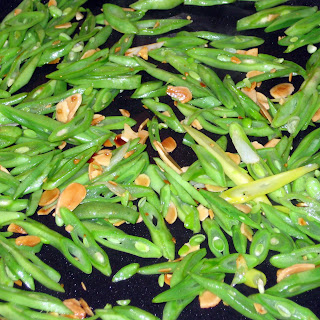Leftover quail eggs, green and yellow beans, and baby greens in the fridge, and a toasty 106 degrees outside? Clearly the evening called for a cool summertime salad and a distinct lack of grocery-shopping. I've never found Nicoise salads to be particularly appealing (partly because I don't like most olives, so here I substituted a green variety that isn't pickled, which makes it taste much more olive oil-esque and less olive-y), but this adulterated version was pretty darn good.
Ingredients
Mixed baby greens & (optional) a handful of baby arugula
1 1/2 cups cooked cannellini beans* (or substitute canned)
1 can (hook-and-line/troll caught) albacore tuna, drained
2-3 shallots, halved and thinly sliced
1 tsp black mustard seeds
Several handfuls green and/or yellow beans
4 quail eggs (or sub 1 regular egg, boiled & sliced)
2-3 tbsp good quality extra virgin olive oil
1 tsp sherry vinegar
Zest of 1 lemon
Sliced olives (green or black)
1 tbsp chopped parsley, plus a little extra for garnish
2 sprigs oregano, finely chopped
Salt & freshly ground black pepper
In a wide pan, heat a little olive oil over medium-high heat. Add shallot and mustard seeds and saute for 1-2 minutes till soft, then add green beans and continue to saute, stirring, until just tender (after a couple minutes, you can add a tbsp of water and cover for a minute or two to cook them quickly without letting them dry out). Set aside to cool.
In a small pot, bring water to a simmer.
Carefully poke holes in the big end of each quail egg with a pushpin (start very gently and twist the pin back and forth, just until it goes through the shell). Lay the eggs in a slotted spoon, then lower into the simmering water for just under 3 minutes. Raise spoon out of

water, drain, and run under cool water for about 20 seconds. Peel each quail egg (by far the best way I found to do this was to gently crack the shell on all sides to smithereens, then gently peel while holding the egg under a light drizzle of cold water). Cut each egg in half and set aside. (As far as we can tell, after eating this salad, quail eggs were invented so that one could eat a medium-boiled egg with some yolk in every bite. If you by any chance feel exceedingly warm and fuzzy toward egg yolks, which certain authors of certain blogs do, quail eggs would be a good thing to track down somewhere and incorporate into some sort of arrangement where they go into your mouth, and you smile in blissful happiness.)
Combine tuna with a little olive oil in a bowl, then add cannellini beans and a little salt and pepper (unless your tuna and/or beans are already very salty -- if so, make sure to taste before you salt more).
Whisk olive oil, sherry vinegar, lemon zest, oregano, parsley, salt, and pepper together in a small bowl.
Toss the greens with a couple spoonfuls of dressing and arrange as a bed on each plate. Top with green beans on one side, white beans and tuna on the other. Drizzle with 1-2 more spoonfuls of dressing per plate. Sprinkle extra shallots from the pan over the top, along with the olives and extra parsley, and arrange the eggs on the top. Garnish with a sprig of parsley or oregano, and serve. (If it tastes at all bland, it needs a bit more salt and/or pepper to help the flavors pop out.)
Serves 2.
*Rinse and pick through dried beans carefully, then soak overnight in cold water, or put in a pot with enough water to cover by 1-2 inches and bring to a boil, simmer for 2-3 minutes, then turn off heat and let soak for an hour. Then, put in a pot with fresh water (about an inch above the beans), a bay leaf, and a few whole peeled garlic cloves, bring to a boil, and simmer for 60-90 minutes until tender.


























